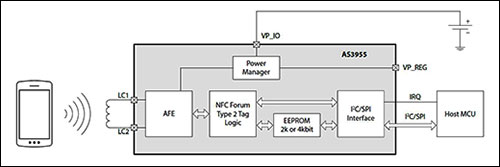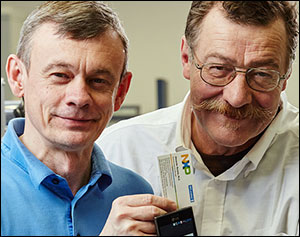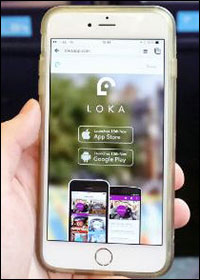The following are news announcements made during the past week by the following organizations:
ams; the
University of Manchester, BGT Materials Ltd.;
NXP Semiconductors;
Proxama, Exterion Media;
Intergraph, and Blue Iron Systems.
Ams Launches Energy-Harvesting NFC Chip
Ams AG has launched the AS3955, a Near Field Communication (NFC) interface chip that features energy harvesting and data-transfer capabilities. According to ams, the AS3955 is designed to provide a contactless bridge between an NFC reader (for instance, a smartphone or tablet) and a microcontroller residing on the host device. The AS3955 can also act as a power supply for the host device, the company reports, harvesting as much as 5mA at 4.5 volts—enough to charge a lithium-ion cell battery—from the RF energy radiated by an NFC reader.
The AS3955 is available with two bi-directional data-transfer modes: The extended mode allows the use of standard NFC tag commands to transfer data with minimum processing overhead on the host microcontroller, while the tunneling mode provides a flexible channel between the reader and the host microcontroller. Together, the two modes let a user implement any standard or proprietary communication protocol. Neither mode requires data buffering in the AS3955’s EEPROM memory (2 kilobits or 4 kilobits), resulting in faster data transfers, according to ams.
The AS3955 features an RF front end that connects to a simple external NFC antenna without additional external components required. The chip also includes an SPI or I2C interface for communication with a microcontroller on the host device. The chip is fully compliant with the ISO1 4443A standard up to Level 4, as well as with NFC Forum specifications, supporting both Type 2 Tag standalone functionality, and Type 4 Tag emulation in combination with an external MCU.
The energy that the AS3955 harvests from an NFC reader enables it to operate without an external power supply. This harvested energy can also be used to power external circuitry on the host device, enabling the implementation of standalone, eco-friendly, battery-less product designs, such as wireless sensor interfaces, interactive games and toys, smart price tags in shops and smart payment cards. The AS3955 can operate in stealth mode, which enables the host MCU to deactivate the AS3955’s RF channel via the I2C or SPI interface after an operation, such as Bluetooth pairing, has been completed successfully. According to ams, this feature provides for guaranteed user control of NFC operation. The AS3955 also offers 32-bit password protection of its EEPROM memory.
The AS3955 also has a silent mode for fail-safe Bluetooth pairing—if the host’s battery has an insufficient remaining charge to power its Bluetooth module, the chip automatically disables its RF circuitry to prevent the device from initiating a pairing procedure.
The energy- and data-management features are suitable for a range of uses in industrial, consumer and gaming equipment, ams reports. Products can be configured or personalized, for instance, at the end of a factory’s production line, without the need to be powered. The high transfer speed and energy-harvesting capability reduce the amount of time required to download configuration data, according to ams, thereby helping to increase throughput in high-volume manufacturing lines.
The AS3955 is available now in production volumes in a 10-pin MLPD package measuring 3 millimeters (0.1 inch) by 3 millimeters (0.1 inch). Wafer-level chip scale package (WL-CSP) and sawn wafer are available on request. In the WL-CSP version, unit pricing is $0.98 each in an order quantity of 1,000 pieces. A demonstration kit for the AS3955 is available online from the ams’ ICdirect web store.
Manchester, BGT Materials Scientists Print Low-Cost Graphene Antenna
A group of scientists have moved graphene—a strong, conductive, single-atom-thick sheet of carbon—a significant step forward toward commercial viability as new next-generation electronic applications.
Researchers from the University of Manchester and BGT Materials Ltd., a graphene manufacturer in the United Kingdom, have announced that they have printed an RF antenna using compressed graphene ink. The antenna performed well enough to make it practical for use in RFID tags and wireless sensors, according to the researchers. The antenna is flexible and environmentally friendly, and could be cheaply mass-produced, they report. The results appear in the latest issue of Applied Physics Letters, a scientific journal published by the American Institute of Physics (AIP).
The study demonstrates that printable graphene is now ready for commercial use in low-cost radio frequency applications, the scientists report.
“The point is that graphene is no longer just a scientific wonder. It will bring many new applications to our daily life very soon,” said Kostya S. Novoselov in a prepared statement. Novoselov, the project’s coordinator—who won the Noble Prize for physics in 2010 for “groundbreaking experiments regarding the two-dimensional material graphene”—is a professor at the University of Manchester’s School of Physics and Astronomy.
Graphene was first isolated and tested in 2004, according to AIP. One of the first commercial products manufactured from graphene was conductive ink, which can be used to print circuits and other electronic components. Graphene ink is generally low-cost and mechanically flexible—advantages that it has over other types of conductive ink, the researchers note, such as solutions made from metal nanoparticles.
To make the ink, graphene flakes are generally mixed with a solvent, and a binder like ethyl cellulose is sometimes added to help the ink stick. Graphene ink with binders usually conducts electricity better than binder-free ink, but only after the binder material, which is an insulator, is broken down in a high-heat process known as annealing. Annealing, however, limits the types of surfaces onto which graphene ink can be printed because the high temperatures destroy materials like paper or plastic.
The University of Manchester and BGT Materials research team found a way to increase the conductivity of graphene ink without resorting to a binder, by first printing and drying the ink, and then compressing it with a roller, similar to the way in which new pavement is compressed using a road roller. The resulting “graphene laminate” was almost two times more conductive than previous graphene ink made with a binder, the researchers say, and that enabled efficient RF radiation.
The group then tested the compressed graphene laminate by printing a graphene antenna onto a piece of paper. According to the researchers, the antenna measured approximately 14 centimeters (0.6 inch) long and 3.5 millimeters (0.1 inch) across, and radiated RF power effectively.
Printing electronics onto cheap, flexible materials like paper and plastic—instead of more expensive, traditional materials like aluminum and copper—could make RFID tags and other wireless technologies more common, the researchers indicate. The University of Manchester and BGT Materials Limited team say they have plans to further develop graphene-based RFID tags, as well as sensors and wearable electronics.
NXP Engineers Nominated for European Inventor Award 2015 for NFC Work
Two engineers—Austrian Franz Amtmann and Frenchman Philippe Maugars, who were both instrumental in inventing Near Field Communication (NFC) technology—have been nominated as finalists for the European Inventor Award 2015, according to the European Patent Office.
Co-invented by researchers working at NXP Semiconductors (formerly Philips Semiconductors) and Sony in 2002, NFC technology now connects hundreds of millions of smartphones, tablets and other consumer electronics. Amtmann, who has been part of first Philips Semiconductors and now NXP for nearly 25 years, led a team of engineers that helped design the contactless communication technology at NFC’s core. He has been involved in more than 50 patents or patent filings dealing with RFID.
Maugars worked for Philips and NXP for 30 years as a software developer for consumer electronics products, and was instrumental in the development of NFC and its applications. He, along with Patrice Gamand, patented a method for ensuring a secure connection within an NFC circuit. Maguars, a trained mathematician and former university math professor, joined Philips in 1983. Throughout his 30-year career, Maugars’ work has spanned fields ranging from smart card readers to solid-state lighting and cellular communications systems. He is an inventor or co-inventor on more than 25 patents. In 2013, Maugars started his own company, which cooperates closely with NXP.
Thirteen others have been nominated in five categories for the 10th edition of the European Inventor Award. The winners will be revealed at a ceremony in Paris on June 11, 2015.
Proxama Wins Contract From Exterion Media for Beacon-based Deployment
Proxama, a mobile commerce company specializing in proximity marketing and payment solutions that use Bluetooth beacons and NFC RFID technology, has announced that it has been awarded a contract with Exterion Media UK, a European out-of-home advertising and media provider. Proxama also announced that it has been awarded a £1 million ($1.6 million) grant by Innovate UK, an executive non-departmental public body, which is sponsored by the U.K government’s Department for Business, Innovation & Skills. Innovate UK is aimed at supporting the United Kingdom’s high streets—main commercial and retail streets in towns and cities, similar to main streets in the United States.
Proxama’s proximity marketing division, which focuses on connecting consumers to retailers and brands via Bluetooth beacon technology, will provide Exterion with a managed service to deliver proximity marketing services to consumers’ smartphones as they use public transportation. The first phase will build on a trial conducted on buses in Norwich late last year, with a rollout to major cities in the United Kingdom. That trial, which includes approximately 20 merchants from the Norwich area, leverage’s Proxama’s Loka location-based app that provides relevant content and offers (available on Android and iOS), which acts as a network for local brands and gives these retailers a unique channel of communication to potential customers on the move. At the same time, shoppers have the opportunity to discover and purchase new products, as well as receive rewards, such as coupons, discounts and loyalty services.
The £1 million grant from Innovate UK is the second from the organization, according to Proxama. Last June, the company announced that it had been granted £100,000 ($157,000) from Innovate UK to develop mobile proximity marketing and loyalty services across the City of Norwich. The initial £100,000 grant enabled Proxama to create Loka, which allows merchants to engage shoppers by using Bluetooth beacon technology to deliver promotions and information as they pass by their stores. The additional £1 million, according to Proxama, will allow a full-scale rollout to other U.K. cities, in addition to further development around the technology.
Intergraph Acquires Blue Iron Systems, Inc.
Intergraph Process, Power & Marine, part of Hexagon and a provider of enterprise engineering software to the process, power and marine industries, has announced that it has acquired Blue Iron Systems Inc., a provider of RFID-enabled solutions for material management and tracking for large-scale construction projects, headquartered in Calgary, Alberta.
Blue Iron Systems’ Ironscan offers RFID and bar-code tagging technologies as part of a fully integrated plug-in for Intergraph’s SmartPlant Materials, an integrated life-cycle material and supply chain subcontracting management solution. It provides a common collaboration platform and project workbench for all partners in any engineering, procurement and construction project supply chain. IronScan is a bolt-on application to SmartPlant Materials that gathers material site data. No integration is required between IronScan and SmartPlant Materials, Intergraph reports.
The technology will allow Intergraph’s customers—engineering, procurement and construction firms, and owner operators—to track materials in real time, Intergraph reports, directly from the manufacturers’ and suppliers’ facilities to the construction site, and further into facilities’ management and maintenance phases. Ironscan is designed to improve efficiencies in procurement and supply chain management for both project and asset life cycles. The acquisition, Integraph says, reinforces its long-term commitment to its customers and to the marketplace for continually delivering the latest advancements in technology that directly improve and positively impact the bottom line of customers’ projects.
Blue Iron Systems brings to Intergraph 15 years of software-engineering experience and 10 years of materials-management experience with large-scale oil and gas projects. Blue Iron’s founder and staff have joined Intergraph as part of the acquisition, and will be based in Calgary.
“Blue Iron Systems’ Ironscan and its RFID and bar code tagging technology greatly enhances SmartPlant Materials capabilities. This addresses a crucial part of our clients’ needs in the procurement and materials/supply chain management aspects of their projects. Ironscan will specifically increase efficiency at receiving sites, material warehouses and fabrication shops with up to 90 percent reduction in material receiving work-hours,” said Michael Buss, Intergraph’s senior VP, in a prepared statement. “The integrated SmartPlant Materials and Ironscan solution will eliminate waste by not having material left over that was not properly inventoried originally and subsequently repurchased, adding unnecessary cost to projects.”





